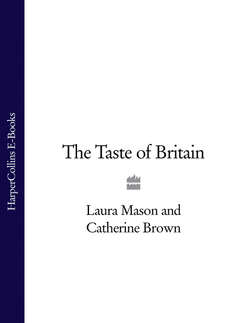Читать книгу The Taste of Britain - Hugh Fearnley-Whittingstall - Страница 19
TECHNIQUE:
ОглавлениеClotted cream requires long slow heating at a moderate temperature. The craft method is as follows: both unpasteurized and pasteurized milk are used. Traditionalists prefer the excellent flavour of unpasteurized milk from Channel Island cattle which has a high butterfat content. The cream is separated from the milk and kept overnight; it may be ripened if desired. The cream, contained in enamel pans, is placed in a bain-marie and heated gently for about 2 hours. This process is crucial; the time and temperature must be correct; only experience will teach the right combination. The temperature of the bain-marie is maintained at below boiling, about 82°C. Once the correct golden, honeycomb crust has formed, the pans are removed from the heat. Industrial methods work on the same principle, but heating takes place either in an oven or in steam cabinets.
Before the advent of milk separators, cream would be clotted on the whole milk. First, the cream would be allowed to rise naturally on the pan of milk saved from one of the day’s milkings. If the morning milk, it would be left until late in the afternoon; if the evening’s, then left overnight. The pan was placed carefully over the fire and it was scalded, as described above. In small farmhouses, the pan would be placed over the kitchen hearth; in larger households, the dairy might have a special stove constructed from a stone slab pierced with holes big enough to accommodate the pans safely. A charcoal brazier could be placed beneath each pan. These pans were of brass or of earthenware. Once the cream was scalded and had clotted, it was skimmed off the milk and stored in flat dishes. Brears (1998) provides illustrations.
Clotted-cream butter is made on a small scale by craft producers. Instead of stirring the cream by hand, as was done in the past, an electric whisk is now used. The cream is whipped until crumbly and worked by hand to squeeze out as much moisture as possible. It is washed in cold water, then beaten with a boiled cloth on a wooden platter. It is pressed by hand into a mould to make round pats.
